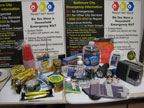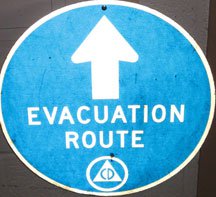 Where to Get Information
Where to Get Information
- When you hear the outdoor alert sirens, tune to your local TV or radio news station for information.
- Sirens are tested every Monday at 1:00pm
- Emergency updates will be posted on www.baltimorecity.gov
- Tune to your NOAA Alert Radio for severe weather updates
Who to Call
- Call 911 to report a life-threatening emergency
- Call 311 to report a non-emergency or to request City services
- Call (888) 223-0033 to report suspicious activity
- Call (877) 778-2222 to report a power outage to BGE
- Call (410) 396-3098 for recorded information during an emergency
What to Do
In an emergency you may be instructed to SHELTER IN PLACE orEVACUATE
Shelter in Place
- Bring your family and pets inside.
- Lock doors, close windows, air vents and fireplace dampers.
- Turn off fans, air conditioning and forced air heating systems.
- Take your emergency supply kit unless you have reason to believe it has been contaminated. The kit consists of:
- Water, one gallon of water per person per day for at least three days, for drinking and sanitation
- Food, at least a three-day supply of non-perishable food
- Battery-powered or hand crank radio and a NOAA Weather Radio with tone alert and extra batteries for both
- Flashlight and extra batteries
- First aid kit
- Whistle to signal for help
- Dust mask, to help filter contaminated air and plastic sheeting and duct tape to shelter-in-place
- Moist towelettes, garbage bags and plastic ties for personal sanitation
- Wrench or pliers to turn off utilities
- Can opener for food (if kit contains canned food)
- Local maps
- Cell phone with chargers
- Go into an interior room with few windows, if possible.
- Seal all windows, doors and air vents with plastic sheeting and duct tape. Consider measuring and cutting the sheeting in advance to save time.
- Be prepared to improvise and use what you have on hand to seal gaps so that you create a barrier between yourself and any contamination.
- Local authorities may not immediately be able to provide information on what is happening and what you should do. However, you should watch TV, listen to the radio or check the Internet often for official news and instructions as they become available.
 Evacuate
Evacuate
- Lock the door behind you.
- Take your pets with you, but understand that only service animals may be permitted in public shelters. Plan how you will care for your pets in an emergency.
If time allows: - Call or email the "out-of-state" contact in your family communications plan.
- Tell them where you are going.
- If there is damage to your home and you are instructed to do so, shut off water, gas and electricity before leaving.
Leave a note telling others when you left and where you are going. Check with neighbors who may need a ride.
(Information courtesy of US DHS, www.ready.gov)


 Where to Get Information
Where to Get Information Evacuate
Evacuate